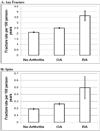Arthritis increases the risk for fractures--results from the Women's Health Initiative
- PMID: 21572148
- PMCID: PMC3149716
- DOI: 10.3899/jrheum.101196
Arthritis increases the risk for fractures--results from the Women's Health Initiative
Abstract
Objective: To examine the relationship between arthritis and fracture.
Methods: Women were classified into 3 self-reported groups at baseline: no arthritis (n = 83,295), osteoarthritis (OA; n = 63,402), and rheumatoid arthritis (RA; n = 960). Incident fractures were self-reported throughout followup. Age-adjusted fracture rates by arthritis category were generated, and the Cox proportional hazards model was used to test the association between arthritis and fracture.
Results: After an average of 7.80 years, 24,137 total fractures were reported including 2559 self-reported clinical spinal fractures and 1698 adjudicated hip fractures. For each fracture type, age-adjusted fracture rates were highest in the RA group and lowest in the nonarthritic group. After adjustment for several covariates, report of arthritis was associated with increased risk for spine, hip, and any clinical fractures. Compared to the nonarthritis group, the risk of sustaining any clinical fracture in the OA group was HR 1.09 (95% CI 1.05, 1.13; p < 0.001) and HR 1.49 (95% CI 1.26, 1.75; p < 0.001) in the RA group. The risk of sustaining a hip fracture was not statistically increased in the OA group (HR 1.11; 95% CI 0.98, 1.25; p = 0.122) compared to the nonarthritis group; however, the risk of hip fracture increased significantly (HR 3.03; 95% CI 2.03, 4.51; p < 0.001) in the RA group compared to the nonarthritis group.
Conclusion: The increase in fracture risk confirms the importance of fracture prevention in patients with RA and OA.
Figures


References
-
- Holroyd C, Cooper C, Dennison E. Epidemiology of osteoporosis. Best Pract Res Clin Endocrinol Metab. 2008 Oct;22(5):671–685. - PubMed
-
- Kanis JA, Johansson H, Oden A, McCloskey EV. Assessment of fracture risk. Eur J Radiol. 2009 Sep;71(3):392–397. - PubMed
-
- Alamanos Y, Drosos AA. Epidemiology of adult rheumatoid arthritis. Autoimmun Rev. 2005 Mar;4(3):130–136. - PubMed
-
- Hochberg MC, Lethbridge-Cejku M, Tobin JD. Bone mineral density and osteoarthritis: data from the Baltimore Longitudinal Study of Aging. Osteoarthritis Cartilage. 2004;12 Suppl A:S45–S48. - PubMed
Publication types
MeSH terms
Grants and funding
LinkOut - more resources
Full Text Sources
Medical
